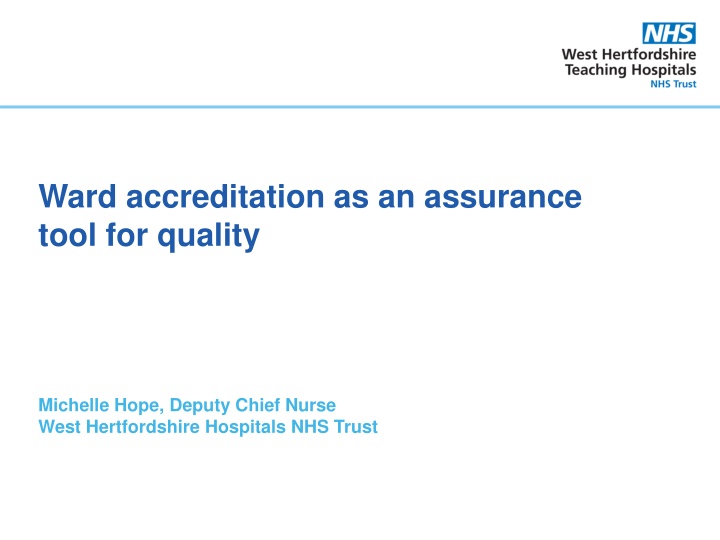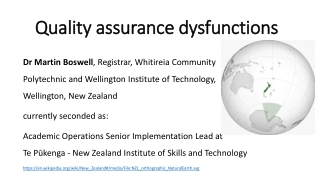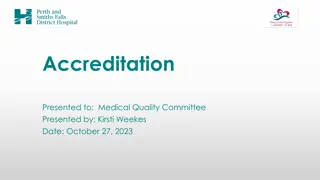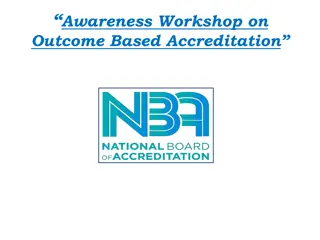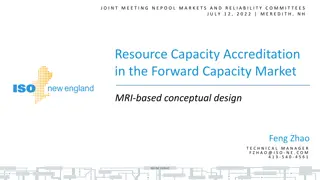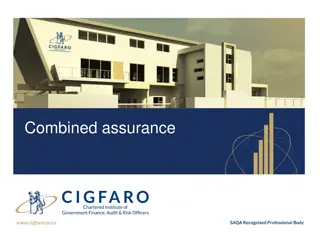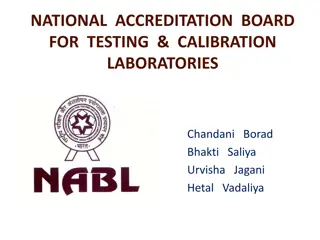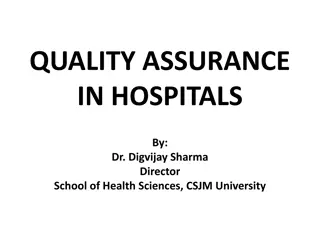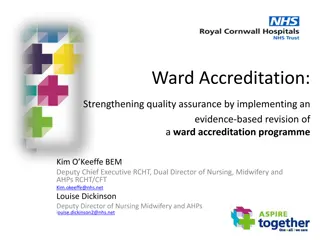Ward Accreditation as an Assurance Tool for Quality in Healthcare
Exploring the concept of ward accreditation as a tool for ensuring quality in healthcare settings. Michelle Hope, Deputy Chief Nurse at West Hertfordshire Hospitals NHS Trust, discusses the importance of encouraging staff engagement, sharing best practices, and enhancing pride within clinical departments. The process involves comprehensive assessments, data collection, and adherence to nine key standards to drive continuous quality improvement at the ward level.
Download Presentation

Please find below an Image/Link to download the presentation.
The content on the website is provided AS IS for your information and personal use only. It may not be sold, licensed, or shared on other websites without obtaining consent from the author.If you encounter any issues during the download, it is possible that the publisher has removed the file from their server.
You are allowed to download the files provided on this website for personal or commercial use, subject to the condition that they are used lawfully. All files are the property of their respective owners.
The content on the website is provided AS IS for your information and personal use only. It may not be sold, licensed, or shared on other websites without obtaining consent from the author.
E N D
Presentation Transcript
Ward accreditation as an assurance tool for quality Michelle Hope, Deputy Chief Nurse West Hertfordshire Hospitals NHS Trust
Introduction Ward accreditation explained Encouraging ownership of continuous quality improvement at ward level Engaging and empowering staff to improve the basic standards and quality of care at ward level and reduce variation in standards between wards & clinical departments Sharing best practice across wards & clinical departments Increasing staff pride within their areas
Ward accreditation explained The Chief Nursing Officer for England identifies ward accreditation as having potential to enable nursing and midwifery to lead on improvement and sharing of learning and good practice Ward accreditation is a framework that enables a comprehensive assessment of the quality of care delivered at ward level _____________________________________________________________ Wards & Clinical Departments Accredited Clinical Environment ACE Going for silver
Data Test Your Care Trust reports incl. workforce data, training records Ward Score Card Data collection Observation audit of patient records and clinical environment Matrons Quality Checks Infection Prevention Control Dashboard Patient Experience Questionnaire
9 Standards Nutrition & Hydration Person Centred Care Dignity & Respect Leadership & Professionalism Clinical Governance Consent Safe Care & Treatment Safeguarding Infection Control
How to choose your metrics To determine which factors, contribute to a successful ward accreditation programme I needed to review the scoring criteria. To comply with secondary research ethics approval I utilised professional networks within the NHS to request copies of their scoring tools for analysis. An email was sent to 28 contacts whose Trust had been identified in the public domain as having a ward accreditation programme in place, the response rate was 15. The standards used in the ward accreditation of these 15 NHS Trusts was compiled in a spreadsheet; the number of standards varied from 5 to 39 with a mean of 14.8. There was a total of 68 different standards identified with some of these merged by the author, for example elimination/ continence & catheter care were grouped into 1 theme. A variety of themes and standards are available with some key themes emerging as consistently used in scoring criteria. In line with the mean of 14.8 themes or standards there were 15 which appeared in more than a third of the responses.
16 standards No. Standards The 15 most frequently occurring standards were checked against the CQC fundamental standards and there were 2 exceptions that were not reflected in the final 15: are complaints and clinical governance, complaints were one of the themes merged by the author into the overarching theme of clinical governance and 26% of NHS Trusts had this in their standards however it was excluded from the list of 15 as it was below the 30% used to identify the most frequently used standards and as such was not included in the final 15. For this reason, I added this standard to have a final set of 16 standards. 1 Communication 2 Elimination/ continence / catheter care 3 End of life care 4 Environment 5 Falls 6 Infection prevention & control 7 Leadership/ management/ organisation 8 Medication 9 Nutrition & hydration Additionally, the display of CQC rating is one of the CQC fundamental standards which is not included in the final 16 ward accreditation standards. 10 Patient experience/ feedback/ Friends & Family Test 11 Patient flow/ admission/ transfer/ discharge 12 Pressure ulcers 13 Record keeping / documentation 14 Safeguarding / mental capacity 15 Staff skill & knowledge/ development/ training/ support 16 Clinical governance
MBA findings As an output from the accreditation process Wards and departments are awarded a rating based on their success in meeting these standards and these ratings varied between colours such as red, amber, green or gold, silver, bronze to identify the outcome of the assessment. There were also references to white, requires improvement, satisfactory and foundation to identify those wards which are under performing. The medal colours were most often used with bronze 47%, silver 47%, gold 40% & platinum 33%.
Encouraging ownership of continuous quality improvement at ward level Gap analysis Going for silver During the pause of impact assessment due to the EPR rollout a gap analysis was undertaken to review current progress on the following criteria: preparation, undertaking, feedback, outcomes
Engaging and empowering staff to improve the basic standards and quality of care at ward level and reduce variation in standards between wards Peer review With not to Not punitive we want you to succeed and share successes
The assessment/inspection, ratings/ standards, reward, sharing learning & feedback. Relaunch under the working title of going for silver to support all clinical areas to aspire towards improved ratings. The ratings should also be re-evaluated Gold will replace platinum as the highest rating with a new level white added for those who haven t received bronze during an assessment. All wards will start with a bronze rating in recognition of the 2020 impact analysis rating with the ambition being that in 12 months time all wards will achieve silver rating. areas for improvement are grouped into 5 themes:
Sharing best practice across wards Peer review
Increasing staff pride within their areas Going for Gold ..
